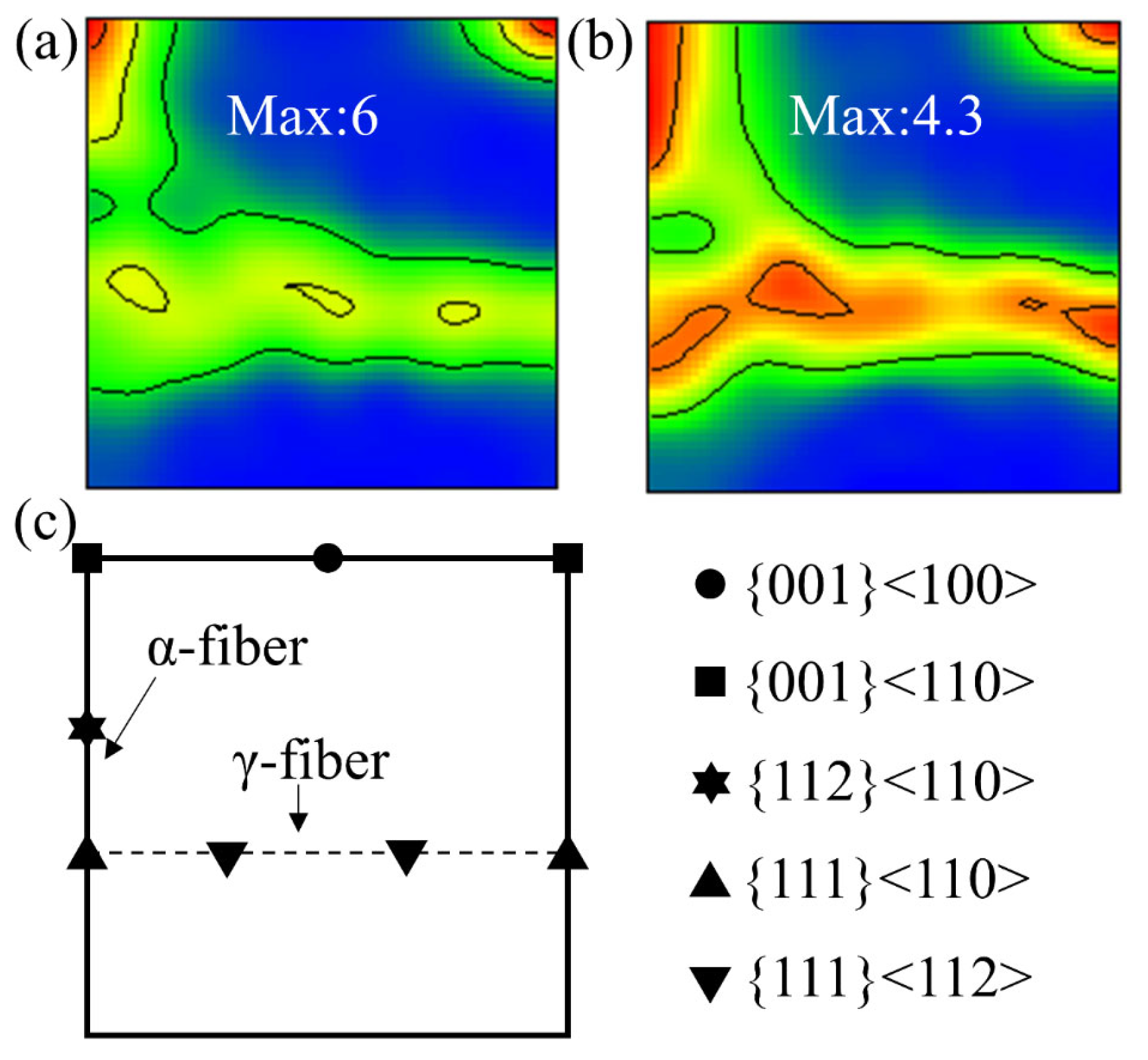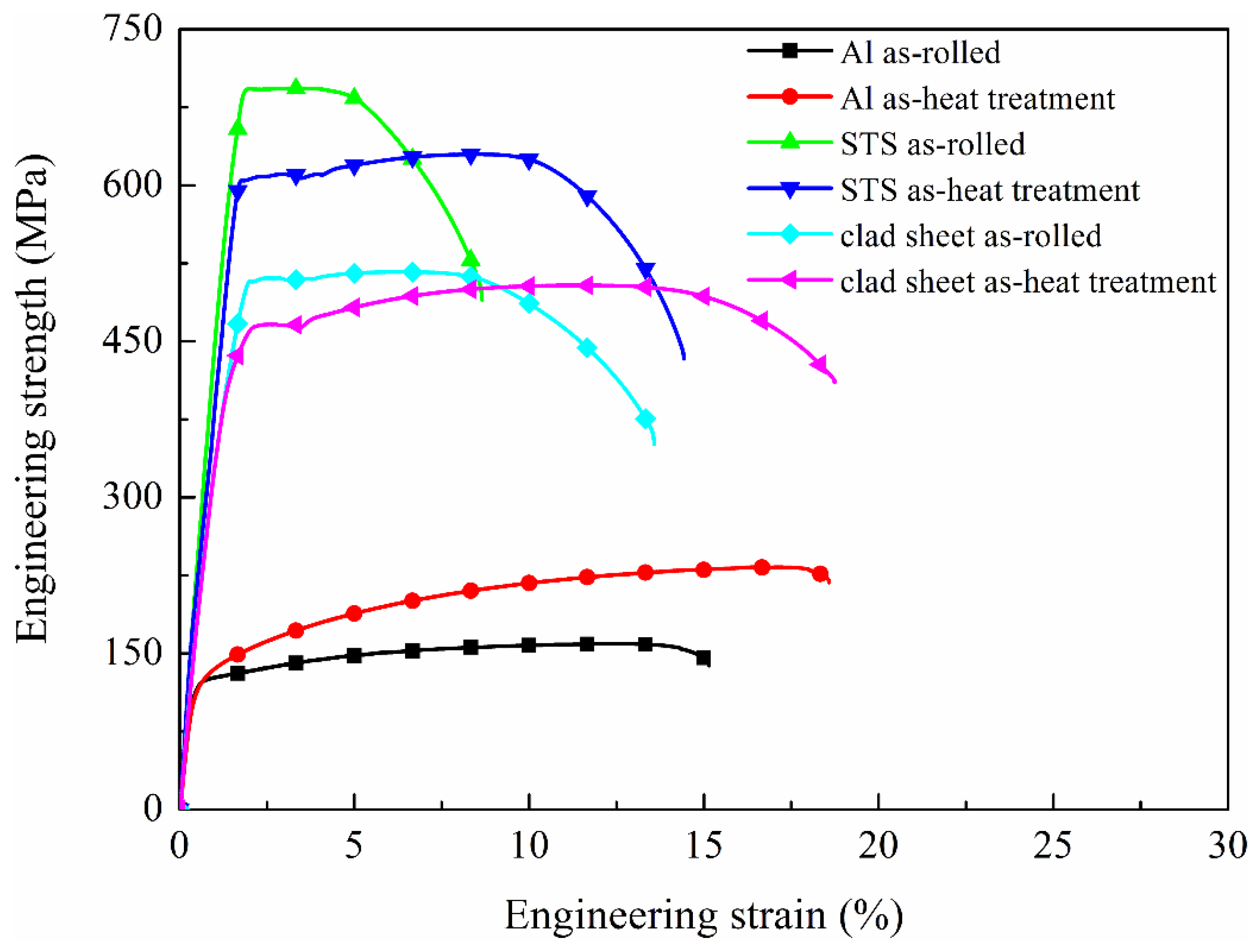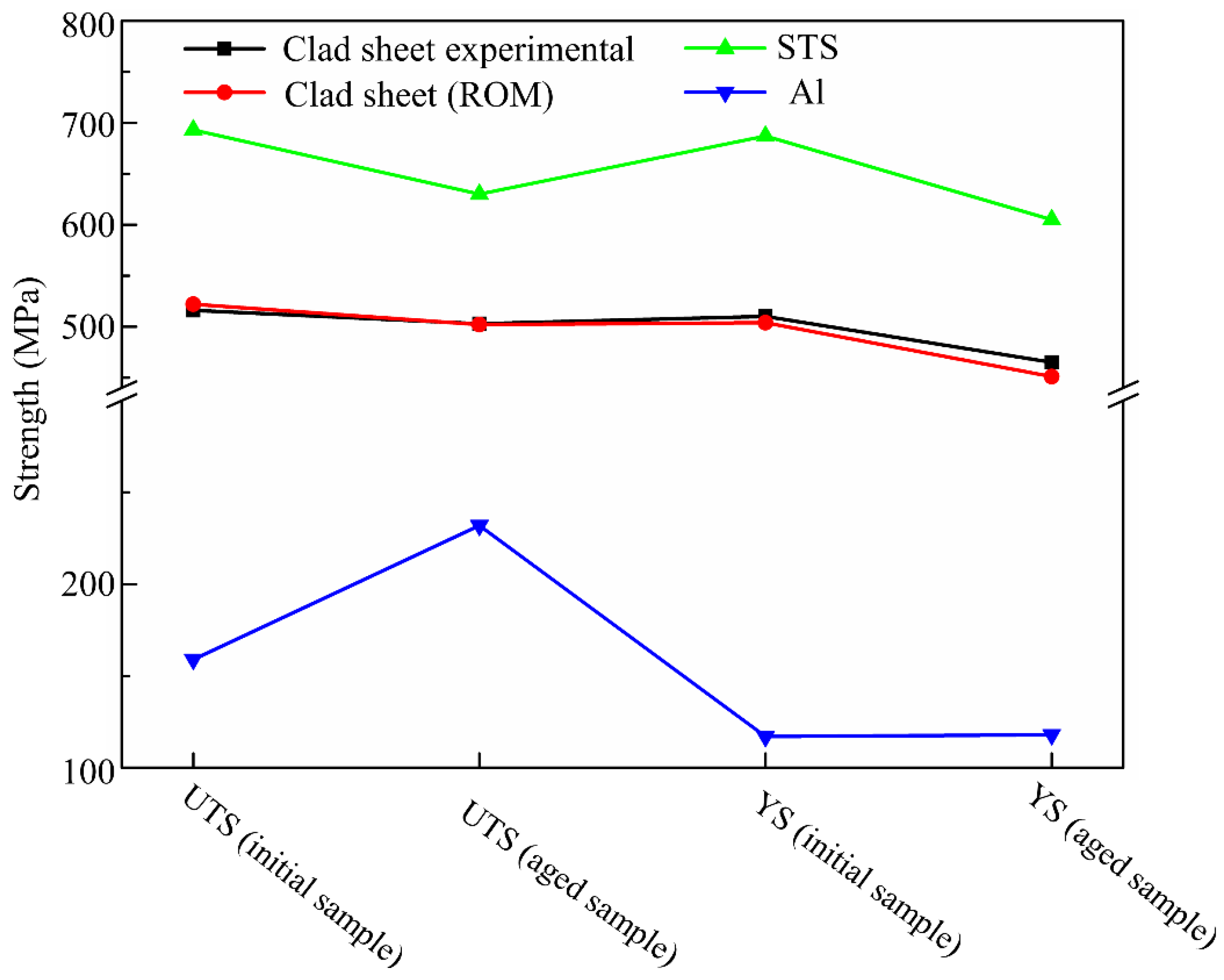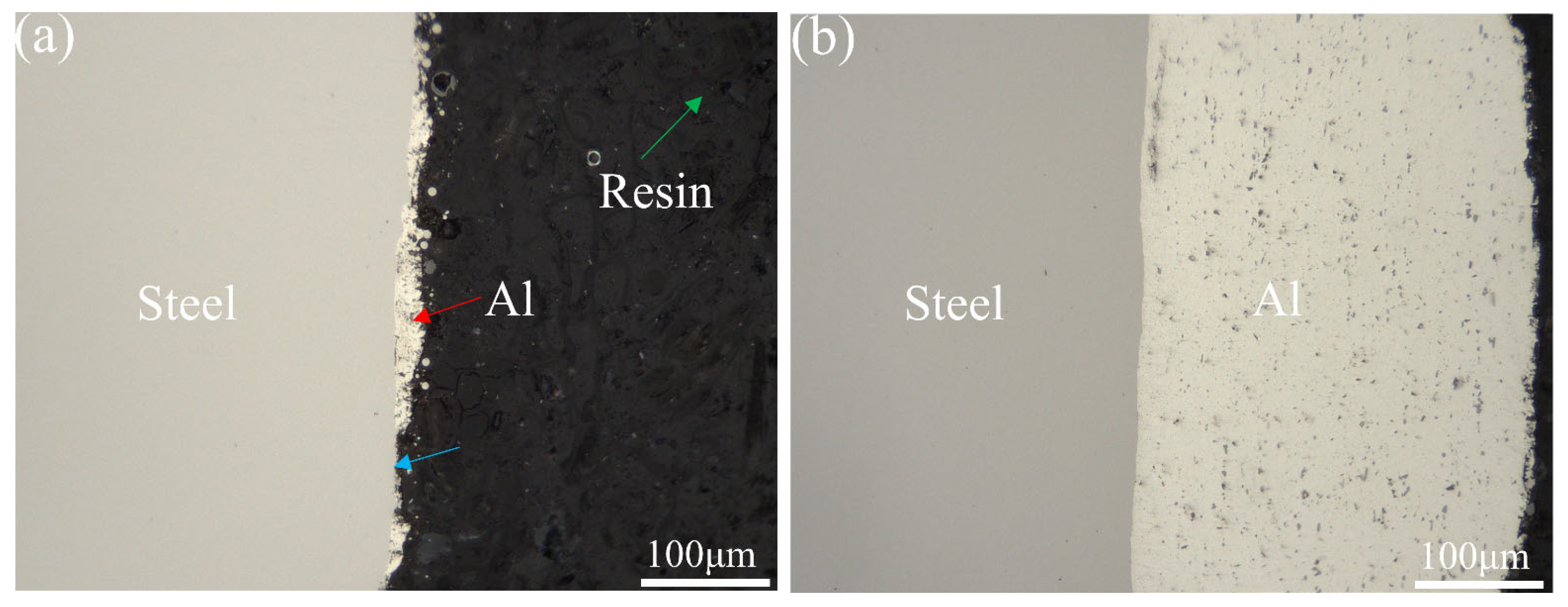Fabrication of AlZn4SiPb/Steel Clad Sheets by Roll Bonding: Their Microstructure and Mechanical Properties
Abstract
:1. Introduction
2. Materials and Methods
3. Results and Discussion
3.1. Microstructure of AlZn4SiPb/Steel Clad Sheets
3.2. Tensile Properties of AlZn4SiPb/Steel Clad Sheets
3.3. Bonding Strength of AlZn4SiPb/Steel Interface
4. Conclusions
- (1)
- The AlZn4SiPb/steel clad sheets demonstrate a satisfactory interfacial bonding. An uneven interfacial transition area with a thickness of 30–150 nm was observed in the aged sample.
- (2)
- The Pb of the aged Al matrix is spheroidized and uniformly dispersed. Some rod-shaped nanoscale β’ phases were observed in the aged Al matrix.
- (3)
- After the solution and aging treatment, the tensile strength of the individual metal of steel layer decreased, while that of the individual Al layer increased. Moreover, the γ-fibre texture of the steel layer improved.
- (4)
- In contrast, the aged sample has a lower yield ratio than that of the initial clad composite. The UTS and YS values of the composites are consistent with the computed values from the ROM. The interfacial bonding strength of the initial sample is 70 MPa, while that of the aged sample is 130 MPa.
Author Contributions
Funding
Data Availability Statement
Conflicts of Interest
References
- Lucchetta, M.; Saporiti, F.; Audebert, F. Improvement of surface properties of an Al–Sn–Cu plain bearing alloy produced by rapid solidification. J. Alloys Compd. 2019, 805, 709–717. [Google Scholar] [CrossRef]
- Rusin, N.M.; Skorentsev, A.L.; Krinitcyn, M.G.; Dmitriev, A.I. Tribotechnical properties of sintered antifriction aluminum-based composite under dry friction against steel. Materials 2022, 15, 180. [Google Scholar] [CrossRef]
- Geng, H.; Ma, J. Friction and wear of AlZnPb bearing alloy. Wear 1993, 169, 201–207. [Google Scholar]
- Cui, G.M.; Li, X.X.; Zeng, J.M. Research on Cold-Rolled Bimetal of High-Tin Aluminum Alloy and Steel. Appl. Mech. Mater. 2012, 217–219, 395–399. [Google Scholar] [CrossRef]
- Wang, P.; Chen, Z.; Hu, C.; Li, B.; Mo, T.; Liu, Q. Effects of annealing on the interfacial structures and mechanical properties of hot roll bonded Al/Mg clad sheets. Mater. Sci. Eng. A 2020, 792, 139673. [Google Scholar] [CrossRef]
- Zhang, H.; Niu, T.; Li, Y.; Yuan, M. Influence of high magnetic field-thermal coupling processing on diffusion bonding prop-erties and element diffusion of 1420 Al-Li Alloy. Crystals 2022, 12, 1508. [Google Scholar] [CrossRef]
- Yang, M.; Ma, H.-H.; Shen, Z.-W.; Chen, D.-G.; Deng, Y.-X. Microstructure and mechanical properties of Al-Fe meshing bonding interfaces manufactured by explosive welding. Trans. Nonferrous Met. Soc. China 2019, 29, 680–691. [Google Scholar] [CrossRef]
- Deepika, D.; Anitha Lakshmi, A.; Srinivasa Rao, C.; Sateesh, N.; Nookaraju, B.C.; Subbiah, R. Formability of tailor welded blanks of aluminium alloy and steel-review. Mater. Today Proc. 2021, 46, 722–728. [Google Scholar] [CrossRef]
- Fu, L.; Xiao, H.; Yu, C.; Lv, Q.; Zhang, S.; Xie, H. Bonding enhancement of cold rolling Al/steel composite plates via self-nano film modification. J. Mater. Process. Technol. 2021, 300, 117427. [Google Scholar] [CrossRef]
- Lanzutti, A.; Lekka, M.D.; Leitenburg, C.; Fedrizzi, L. Effect of pulse current on wear behavior of Ni matrix micro-and nano-SiC composite coatings at room and elevated temperature. Tribol. Int. 2019, 132, 50–61. [Google Scholar] [CrossRef]
- Tseluikin, V.N.; Koreshkova, A.A. Pulsed Electrodeposition of Composite Coatings Based on Zinc–Nickel Alloy. Prot. Met. Phys. Chem. Surfaces 2018, 54, 453–456. [Google Scholar] [CrossRef]
- Chen, K.; Liu, W.W.; Wang, T.; Wang, N.J.; Chen, Z.Y. Experimental research on the technology of two-pass different temperature rolling for thick steel/aluminum/aluminum alloy composite plate. Int. Adv. Manuf. Technol. 2022, 120, 7689–7705. [Google Scholar] [CrossRef]
- Filho, A.A.M.; Timokhina, I.; Molotnikov, A.; Hodgson, P.D.; Lapovok, R. Role of shear in interface formation of Aluminium-Steel multilayered composite sheets. Mater. Sci. Eng. A 2017, 705, 142–152. [Google Scholar]
- Kim, Y.K.; Hong, S.I. Influence of interface structure and stress distribution on fracture and mechanical performance of STS439/Al1050/STS304 clad composite. Mater. Sci. Eng. A 2019, 749, 35–47. [Google Scholar] [CrossRef]
- Chen, G.; Xu, G.M. Interfacial reaction in twin-roll cast AA1100/409L clad sheet during different sequence of cold rolling and annealing. Met. Mater. Int. 2021, 27, 3013–3025. [Google Scholar] [CrossRef]
- Silva, A.P.; Garcia, A.; Spinelli, J.E. Microstructural Morphologies and Experimental Growth Laws during Solidification of Monotectic and Hypermonotectic Al–Pb Alloys. J. Mater. Sci. Technol. 2014, 30, 401–407. [Google Scholar] [CrossRef]
- Mohau, S.; Agarvvala, V.; Ray, S. The effect of lead content on the wear characteristics stir-cast Al-Pb alloy. Wear 1990, 140, 83–92. [Google Scholar]
- Wang, P.; Chen, Z.; Hu, C.; Li, B.; Lin, J.; Liu, Q. Effects of annealing on the interface microstructures and mechanical properties of hot roll bonded Ti6Al4V/AA6061 clad sheets. J. Mater. Res. Technol. 2020, 9, 11813–11825. [Google Scholar] [CrossRef]
- Hirano, K.-I.; Agarwala, R.; Cohen, M. Diffusion of iron, nickel and cobalt in aluminum. Acta Met. 1962, 10, 857–863. [Google Scholar] [CrossRef]
- Yang, Y.; Zhang, F.; He, J.; Qin, Y.; Liu, B.; Yang, M.; Yin, F. Microstructure, growth kinetics and mechanical properties of interface layer for roll bonded aluminum-steel clad sheet annealed under argon gas protection. Vacuum 2018, 151, 189–196. [Google Scholar] [CrossRef]
- Sagalowicz, L.; Lapasset, G.; Hug, G. Transmission electron microscopy study of a precipitate which forms in the Al-Mg-Si system. Philos. Mag. Lett. 1996, 74, 57–66. [Google Scholar] [CrossRef]
- Zhu, Q.; Cao, L.; Wu, X.; Zou, Y.; Couper, M.J. Effect of Ag on age-hardening response of Al-Zn-Mg-Cu alloys. Mater. Sci. Eng. A 2019, 754, 265–268. [Google Scholar] [CrossRef]
- Wolverton, C. Crystal structure and stability of complex precipitate phases in Al-Cu-Mg-(Si) and Al-Zn-Mg alloys. Acta. Mater. 2001, 49, 3129–3142. [Google Scholar] [CrossRef]
- Guo, M.X.; Zhang, X.K.; Zhang, J.S.; Zhuang, L.Z. Effect of Zn addition on the precipitation behaviors of Al-Mg-Si-Cu alloys for automotive applications. J. Mater. Sci. 2017, 52, 1390–1404. [Google Scholar] [CrossRef]
- Mao, H.; Bai, X.; Song, F.; Song, Y.; Jia, Z.; Xu, H.; Wang, Y. Effect of Cd on mechanical properties of Al-Si-Cu-Mg alloys un-der different multi-stage solution heat treatment. Materials 2022, 15, 5101. [Google Scholar] [CrossRef] [PubMed]
- Tikhovskiy, I.; Raabe, D.; Roters, F. Simulation of the deformation texture of a 17%Cr ferritic stainless steel using the texture component crystal plasticity finite element method considering texture gradients. Scr. Mater. 2006, 54, 1537–1542. [Google Scholar] [CrossRef]
- Yan, H.; Bi, H.; Li, X.; Xu, Z. Microstructure, texture and grain boundaries character distribution evolution of ferritic stainless steel during rolling process. J. Mater. Process. Technol. 2009, 209, 2627–2631. [Google Scholar] [CrossRef]
- Chen, W.; He, W.; Chen, Z.; Jiang, B.; Liu, Q. Extraordinary room temperature tensile ductility of laminated Ti/Al composite: Roles of anisotropy and strain rate sensitivity. Int. J. Plast. 2020, 133, 102806. [Google Scholar] [CrossRef]
- Liu, K.; Sheng, X.; Li, Q.; Zhang, M.; Han, N.; He, G.; Zou, J.; Chen, W.; Atrens, A. Microstructure and Strengthening Model of Cu–Fe In-Situ Composites. Materials 2020, 13, 3464. [Google Scholar] [CrossRef]
- Li, B.; Chen, Z.; He, W.; Wang, P.; Lin, J.; Wang, Y.; Peng, L.; Li, J.; Liu, Q. Effect of interlayer material and rolling temperature on microstructures and mechanical properties of titanium/steel clad plates. Mater. Sci. Eng. A 2019, 749, 241–248. [Google Scholar] [CrossRef]
- Yang, B.; Li, Z.; Fan, K.; Liu, B.; Yu, W.; Yin, F. Warm Rolled Temperature Effect on Microstructure and Mechanical Properties of 18Mn/40Si2CrMo Multilayer Composite Steel. Crystals 2022, 12, 1652. [Google Scholar] [CrossRef]
- Lee, K.S.; Bae, S.J.; Lee, H.W.; Kang, S.H. Interface-correlated bonding properties for a roll-bonded Ti/Al 2-ply sheet. Mater. Charact. 2017, 134, 163–171. [Google Scholar] [CrossRef]
- Wang, P.; Huang, H.; Liu, J.; Lin, J.; Liu, Q.; Chen, Z. Microstructure and mechanical properties of Ti6Al4V/AA6061/AZ31 laminated metal composites (LMCs) fabricated by hot roll bonding. J. Alloys Compd. 2020, 861, 157943. [Google Scholar] [CrossRef]











| Al | Zn | Si | Mg | Cu | Fe | Ti | |
|---|---|---|---|---|---|---|---|
| AlZn4SiPb | Bal. | 4.45 | 1.21 | 0.49 | 0.89 | 0.03 | 0.12 |
| Fe | C | Si | Mn | P | S | |
|---|---|---|---|---|---|---|
| Steel | Bal. | 0.09 | 0.25 | 0.30 | 0.03 | 0.03 |
| Test Sample | Test Sheet | UTS (MPa) | YS (MPa) | EL (%) |
|---|---|---|---|---|
| Initial sample | Clad sheet | 516 | 510 | 13.52 |
| Al | 159 | 117 | 15.15 | |
| Steel | 693 | 687 | 8.63 | |
| Aged sample | Clad sheet | 503 | 465 | 18.82 |
| Al | 232 | 118 | 18.59 | |
| Steel | 630 | 605 | 14.38 |
Disclaimer/Publisher’s Note: The statements, opinions and data contained in all publications are solely those of the individual author(s) and contributor(s) and not of MDPI and/or the editor(s). MDPI and/or the editor(s) disclaim responsibility for any injury to people or property resulting from any ideas, methods, instructions or products referred to in the content. |
© 2023 by the authors. Licensee MDPI, Basel, Switzerland. This article is an open access article distributed under the terms and conditions of the Creative Commons Attribution (CC BY) license (https://creativecommons.org/licenses/by/4.0/).
Share and Cite
Wang, P.; Zhong, N.; Tu, L.; Hong, W.; Lv, Y.; Chen, Y.; Sun, J.; Luo, C.; Chen, Z.; Tang, Q. Fabrication of AlZn4SiPb/Steel Clad Sheets by Roll Bonding: Their Microstructure and Mechanical Properties. Crystals 2023, 13, 292. https://doi.org/10.3390/cryst13020292
Wang P, Zhong N, Tu L, Hong W, Lv Y, Chen Y, Sun J, Luo C, Chen Z, Tang Q. Fabrication of AlZn4SiPb/Steel Clad Sheets by Roll Bonding: Their Microstructure and Mechanical Properties. Crystals. 2023; 13(2):292. https://doi.org/10.3390/cryst13020292
Chicago/Turabian StyleWang, Pengju, Ning Zhong, Liyue Tu, Weiming Hong, Yanming Lv, Yonghong Chen, Jian Sun, Caiyong Luo, Zejun Chen, and Qian Tang. 2023. "Fabrication of AlZn4SiPb/Steel Clad Sheets by Roll Bonding: Their Microstructure and Mechanical Properties" Crystals 13, no. 2: 292. https://doi.org/10.3390/cryst13020292
APA StyleWang, P., Zhong, N., Tu, L., Hong, W., Lv, Y., Chen, Y., Sun, J., Luo, C., Chen, Z., & Tang, Q. (2023). Fabrication of AlZn4SiPb/Steel Clad Sheets by Roll Bonding: Their Microstructure and Mechanical Properties. Crystals, 13(2), 292. https://doi.org/10.3390/cryst13020292







